A-G H-N O-R S-Z
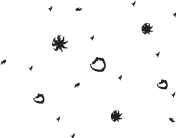
Air: The invisible gases that are floating all around us, all the time. You're breathing it right now! The atmosphere is made up of air. Even though you can't see air, it takes up space and has weight. It doesn't have any color or smell, but you can't fly a kite without it!
Air mass: A huge volume of air, sometimes hundreds (or thousands!) of miles wide. An air mass has about the same temperature and water vapor everywhere inside the bubble. Sometimes they're warm and sometimes they are cold. When warm and cold air masses meet, weather really happens!
Atmosphere: The blanket of air that covers and surrounds our planet. Earth's atmosphere makes it possible for life to exist. It contains helpful gases that plants, animals, and people need to live. The atmosphere allows the sun's rays to pass through it and warm everything up, so we are comfortable and plants can grow. Seeing our atmosphere from space shows us how thin and fragile it is. If Earth were the size of a beach ball, the breathable atmosphere would be as thin as a sheet of paper!
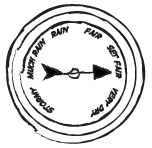
Barometer: A simple instrument used to measure how strong or weak the air pressure is. You can't see air pressure, but it is all around us every day. Scientists use barometers to help predict the weather. When the pressure goes up or down, they know a change is coming.
Climate: The climate where you live is made up of all the different weather patterns that usually happen there. Once you get to know the average weather conditions of a place for a long period of time, then you know what the climate of that place is.

Cloud: Clouds are made up of many, many tiny drops of water. Sometimes they are also full of frozen ice crystals. Clouds form when water drops condense from the atmosphere. They can be big and puffy or thin enough to see the blue sky through them. Some clouds are over 12 miles tall and other ones sit right on the ground.

Cold front: The leading edge of a cold air mass. It's called a front because all of the cooler air mass is behind it. Cold fronts usually start near the North Pole or South Pole and then keep moving until they eventually lose their strength. After the cold front reaches you, you will feel chilly!
Cyclone: A cyclone is a warm air mass that rotates around a center of strong low pressure. Typhoons and hurricanes are both types of cyclone. If the cyclone forms over the Atlantic Ocean or eastern Pacific Ocean, it is called a hurricane. In other parts of the world, they are called typhoons. Cyclones in the Northern Hemisphere spin counterclockwise and those in the Southern Hemisphere spin clockwise. Tropical cyclones usually weaken when they hit land, because they are no longer being fed by the energy from the warm ocean waters. However, they often move far inland, dumping many inches of rain and causing lots of wind damage before they die out completely.
El Niño: A major weather pattern that starts in the Pacific Ocean. An El Niño happens when warm water near the equator gets blown across the ocean by tropical winds and ends up next to South America, Mexico, and California. Pushing all that warm water together creates more water vapor, clouds, and rain than usual. A lot of places get too much rain and have destructive flooding. An El Niño is so big that it affects the whole world's weather.
Fog: Both fog and clouds are formed when water vapor condenses to form tiny droplets or crystals in the air. Fog is a kind of cloud that is so low that it touches the ground. Fog forms when the air near the ground cools enough to turn its water vapor into liquid water. If you drive through fog be very careful and slow down, because it's hard to see!
Front: The place where warmer and cooler air masses meet. It's not just one spot, but a long line, either curved or straight. Forecasters watch the movements of fronts to help predict the weather.
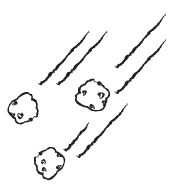
Hail: Frozen balls of ice that fall during a thunderstorm. The gusty winds inside a cloud carry ice crystals up and down. Sooner or later they get heavier and drop out of the clouds as hail. Hail can be as small as a pea or as big as a baseball! Hail is interesting to watch and hear because it bounces off things and makes noise. But if hail is big enough, it can also damage plants, crops, and even break windows!
Heat wave: When the temperature gets a lot hotter than usual. A couple of 95 degree days in Alaska would definitely be a heat wave, but that same temperature in the desert would be no big deal. Heat waves usually last for a few days. Heat waves are serious weather events that are uncomfortable and can be quite dangerous. They are generally the result of trapped air. Instead of moving around like it usually does, the air stays put and warms up like an oven. If you are in a heat wave, stay inside and drink lots of water!

Humidity: The amount of water vapor in the air. If you want to be more specific, it's the percentage of water vapor in the air compared to the maximum amount the air could hold. Humidity varies every day and is different in different places. Changes in humidity can cause the weather to change. When the humidity is high, some people say that it feels 'muggy'.
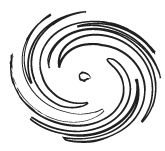
Hurricane: A hurricane is a large storm with very strong winds and lots of rain. Hurricanes are a type of tropical cyclone. They form near the equator over ocean waters that are warm. When the wind speed in a tropical storm reaches 74 mph, it officially a hurricane. The season for hurricanes is from June 1 to November 30. Hurricanes rotate around a central point called the eye of the storm, where the winds are calm. The swirling winds and the low air pressure also cause ocean water to pile up, which is known as a storm surge.
Jet stream: A fast moving river of air high up in the atmosphere. There are two jet streams in the Northern Hemisphere and two in the Southern Hemisphere. Jet streams are caused by the rotation of the Earth and the heating of the atmosphere. They follow the boundaries between large air masses and can affect weather patterns. The jet stream also has an effect on how fast airplanes can go, depending on if the airplane is flying with or against the jet stream.
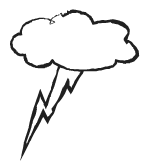
Lightning: Everybody knows that lightning and thunder go together. First you see the bright flash of lightning, then a few seconds later you hear a big boom. It's really cool to watch, but be careful - lighting can cause fires and will hurt if it hits you. So, when you see lightning stay inside in a safe place. Somebody smart said, "when thunder roars, stay indoors!"

Meteorology: The scientific study of Earth's atmosphere, especially how the atmosphere affects the weather.
Ozone layer: Ozone is one of many gases in our atmosphere. There is not a lot of it close to the Earth's surface, but higher up it forms a thin layer in the sky. That ozone layer helps plants, animals, and humans by blocking out some of the Sun's harmful ultraviolet rays. Those are the ones that give you a sunburn!
Precipitation: Rain, snow, hail, drizzle. Anything wet that falls from clouds to the Earth's surface.

Rain: Pure, liquid water that falls from storm clouds. It fills up lakes and makes plants happy. But why does it rain? Moisture rises from Earth's surface into the atmosphere in the form of water vapor. When it cools and condenses up in the air, a cloud forms. Inside the cloud the water vapor grows into droplets. When they get too heavy to stay suspended in the cloud, they fall to Earth as rain. If the air in the cloud is below the freezing point (32 °F or 0 °C) and stays cold all the way down to the ground, you get snow.
Rainbow: Rainbows are beautiful. They always have the same seven colors in them, with red on the outside and violet on the inside. A rainbow will appear when sunlight and other conditions are just right. For a rainbow to form, it requires water drops to be floating in the air. That's why we see rainbows right after it stops raining. The Sun must also be behind you and the clouds cleared away from the Sun for the rainbow to appear.
Season: Earth has seasons because it doesn't stay perfectly straight up and down in its orbit. Scientists think that something might have knocked the young Earth off-center a long time ago. So instead of rotating with its axis perpendicular to its orbital plane, it is tilted about 23 degrees. Sometimes the Northern Hemisphere gets warmed by the sun (summer) and then it's the Southern Hemisphere's turn (winter).
Sleet: Sleet is icy precipitation. Sleet started out as snow up in the clouds, but it passed through a layer of air that was warmer than freezing (32 °F or 0 °C). The warm air made the snowflake melt but then it became icy again before hitting the ground. Think of it like a solid rain drop.

Snow: The soft flakes that fall and make everything white and wintery. Snowflakes grow inside of a cloud when water vapor travels through freezing air and condenses (changes from a gas to a solid) onto a particle. From there it forms into a beautiful, unique crystal with six sides. No two snowflakes are exactly the same.
Thunder: The sound made by a lightning bolt. In a fraction of a second, lightning heats the air around it to incredible temperatures - as hot as 54,000 °F (30,000 °C). That's five times hotter than the Sun! The heated air expands explosively and then contracts really fast. This creates the cracking sound, followed by rumbles as the column of air continues to vibrate.
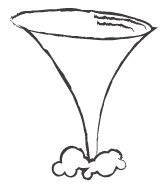
Tornado: Rapidly spinning wind shaped like a cone or funnel. Conditions are ripe for tornadoes when the air becomes unstable inside a big thunderstorm, with blowing winds creating rolling air currents. When it drops down out of the cloud and touches the ground, it's a tornado - and a big problem for anything in its path. The violent winds inside of a tornado have been measured at over 300 miles per hour! If a tornado is near you, hide in a storm cellar or basement for protection.
Troposphere: This is one of the four layers of Earth's atmosphere, and the one closest to the Earth, where we live.

Warm front: The leading edge of a warm air mass.
Weather: Sunshine, rain, cold snaps, heat waves. Weather is what is happening outside right now. The one thing you can be sure of is that the weather will change! Weather is affected by many things, including water vapor, air temperature, and sunlight. Without the atmosphere, there would be no weather - think of the Moon! The Moon has almost no atmosphere and no known weather.

Wind: Wind is basically moving air. We can feel it on our skin and in our hair, and sometimes we hear it when it gets strong enough. It's constantly in motion and pressing down on the Earth and everything in it.
All illustrations credit NOAA/JPL-Caltech




